
I know a couple of business owners in Canmore who were inundated with requests to support every local event, fundraiser or charity for years. Because of the nature of the business, the requests were often for supplies, products or staff to support an event.
They’re generous guys and genuinely like to help the community, but each request failed to consider that they were the fifth one that week. If the guys said they couldn’t help, suddenly they were the villains.
They decided to pick one cause that mattered to them and give their full support. That way, they still got to do their part. And when the inevitable next request came in, they could say, “We’d love to help, but our charitable efforts support (insert name here).”
 I often get requests to donate artwork, money, or even commissions. But years ago, I decided to follow the same route and only donate my time, efforts and funds to support wild animals. For years, I’ve made an automatic monthly donation to The Alberta Birds of Prey Foundation in Coaldale, Alberta.
I often get requests to donate artwork, money, or even commissions. But years ago, I decided to follow the same route and only donate my time, efforts and funds to support wild animals. For years, I’ve made an automatic monthly donation to The Alberta Birds of Prey Foundation in Coaldale, Alberta.
 I know the money they get supports an independent operation with hardworking people. Colin Weir has worked for decades rescuing eagles, owls, hawks and other birds, rehabilitating and releasing them back into the wild. They’re a registered charity and receive no government funding. Though I don’t get there as often as I’d like, each time I go, I see the evidence of their great work.
I know the money they get supports an independent operation with hardworking people. Colin Weir has worked for decades rescuing eagles, owls, hawks and other birds, rehabilitating and releasing them back into the wild. They’re a registered charity and receive no government funding. Though I don’t get there as often as I’d like, each time I go, I see the evidence of their great work.
Though they don’t make a lot of requests and sell my work in their gift shop, I donate my skills to Discovery Wildlife Park. Each year, I update their park map to reflect any changes. I’ve done a life-size cartoon bear portrait for them, and they know they can ask for my help whenever needed.
I’m not breaking the bank with either of those donations, but if I can save them a little on graphic design costs here and there, I’m happy to help. As for the bird sanctuary, regular monthly donations allow a charity or cause to budget for future projects and operating costs because they know that money from their regular donors is coming next month and the month after.
 I hear from time to time that I should do a special edition series or offer some item and give a share of the profits to a charity. When you make a donation contingent on sales, it can come across as a marketing gimmick rather than a genuine desire to help a charity. There’s also little accountability unless you’re willing to open your books to the public. By donating to causes personally important to me, it has nothing to do with whether an item sold well or not.
I hear from time to time that I should do a special edition series or offer some item and give a share of the profits to a charity. When you make a donation contingent on sales, it can come across as a marketing gimmick rather than a genuine desire to help a charity. There’s also little accountability unless you’re willing to open your books to the public. By donating to causes personally important to me, it has nothing to do with whether an item sold well or not.
So today, on Giving Tuesday, a day after the traditional excess of Black Friday and Cyber Monday deals and discount shopping, I have a request. No, I’m not asking you to send me money or buy my stuff.
I’d like to encourage you to find a cause you can support with a small monthly donation.
Do a little research. Find a cause you care about that may not get much support but really needs it. It’s easy to give to the massive global or national machine charities whose names we all know, but many of them are bloated with bureaucracy, and the money you send each month may go to some board member’s parking reimbursement or pay for their breakfast at a convention.
Find something small, maybe even local, where your donation matters. When you can’t donate your time, a little money each month will support the efforts of those who can.
We’re constantly assaulted with bad news, but good people do great work every day to try and make a difference. Help a few of them out if you can.

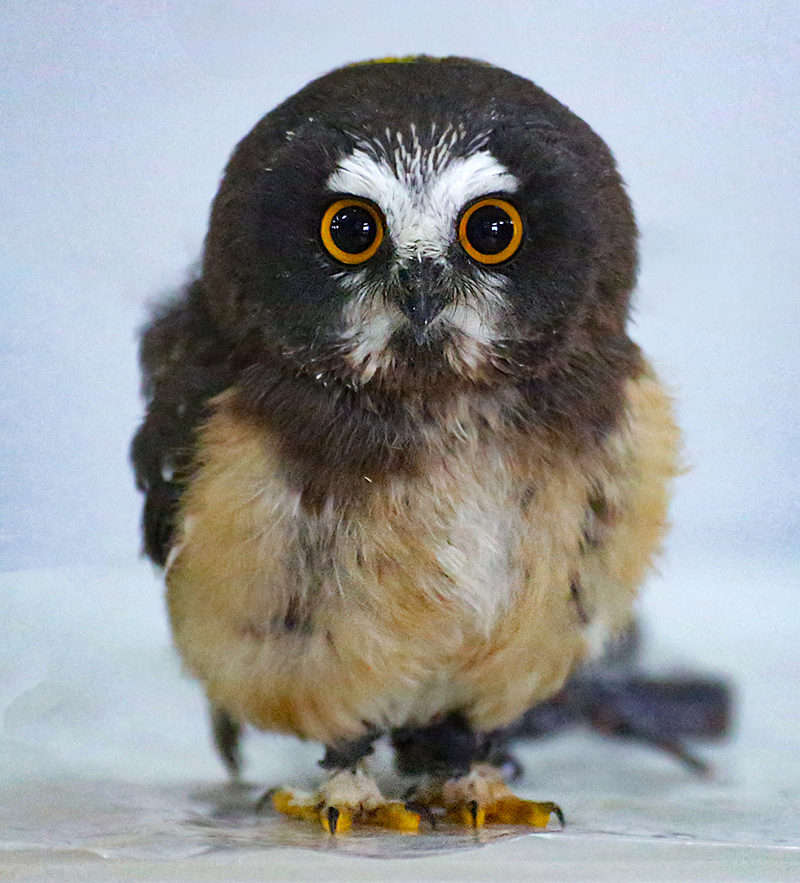

 While I had lunch with my zookeeper friend, Serena, a couple of other people arrived. Coincidentally, they were also longtime friends of the park. Rather than the usual bear education presentation we’d seen several times, Serena gave the three of us a behind-the-scenes personal tour and visit with the bears.
While I had lunch with my zookeeper friend, Serena, a couple of other people arrived. Coincidentally, they were also longtime friends of the park. Rather than the usual bear education presentation we’d seen several times, Serena gave the three of us a behind-the-scenes personal tour and visit with the bears. Cold, dark, and windy, the rain at least let up for a few hours. While the pictures I got weren’t impressive photographs on their own, some of these shots will be amazing for reference. I’ve written before about how sunny days aren’t great because they can wash out detail in the highlights and shadows, but an overcast day provided some very exciting photos of bear fur and features.
Cold, dark, and windy, the rain at least let up for a few hours. While the pictures I got weren’t impressive photographs on their own, some of these shots will be amazing for reference. I’ve written before about how sunny days aren’t great because they can wash out detail in the highlights and shadows, but an overcast day provided some very exciting photos of bear fur and features. If that weren’t enough, Serena has been hand-raising an orphaned raccoon since he was tiny. Shonna I got to see him earlier this summer, but on this day, he was getting his first look at a much bigger world, as he was let loose for a bit to run and play in a large enclosure. If you’ve ever seen a cat or dog with the zoomies, imagine that with a raccoon. He was having a very good time.
If that weren’t enough, Serena has been hand-raising an orphaned raccoon since he was tiny. Shonna I got to see him earlier this summer, but on this day, he was getting his first look at a much bigger world, as he was let loose for a bit to run and play in a large enclosure. If you’ve ever seen a cat or dog with the zoomies, imagine that with a raccoon. He was having a very good time. After the park, I took my parents out to dinner in Red Deer and spent the night at their place for a nice, albeit short, visit.
After the park, I took my parents out to dinner in Red Deer and spent the night at their place for a nice, albeit short, visit. Several years ago, a local photographer told me about
Several years ago, a local photographer told me about Their primary motivation is food, so they’re usually en route to one of the small patches of grass and vegetation among the rocks, where they’ll stuff their faces before running back to their stash. It’s fun to watch.
Their primary motivation is food, so they’re usually en route to one of the small patches of grass and vegetation among the rocks, where they’ll stuff their faces before running back to their stash. It’s fun to watch. It can get cold up there at 2200m (7200 ft), and I always pack extra layers, but it was a pleasant fall morning, and I only needed a light jacket. On a few visits, there’ve been ten or 12 other people, often photographers with much bigger lenses than my 70-300mm, doing the same thing. But on this visit, I spent an hour and a half crawling over the rocks and snapping pics with the whole place to myself. Nobody else stopped.
It can get cold up there at 2200m (7200 ft), and I always pack extra layers, but it was a pleasant fall morning, and I only needed a light jacket. On a few visits, there’ve been ten or 12 other people, often photographers with much bigger lenses than my 70-300mm, doing the same thing. But on this visit, I spent an hour and a half crawling over the rocks and snapping pics with the whole place to myself. Nobody else stopped.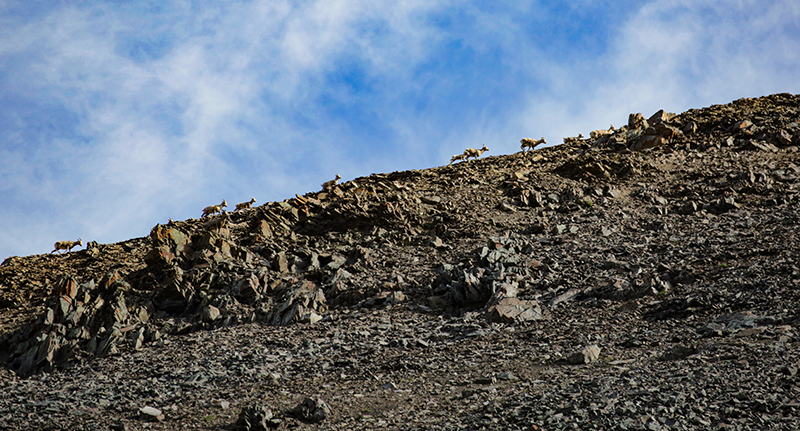 On each drive up to Rock Glacier, I usually see black bears or grizzlies, but none this time. They’re likely still low in the valleys, eating as much as possible before winter. But they can show up anywhere around here, and on these excursions, I’ve always got bear spray on my hip. Aside from the above pic of a line of bighorn sheep walking the top of the ridge, I only saw the wildlife I came for.
On each drive up to Rock Glacier, I usually see black bears or grizzlies, but none this time. They’re likely still low in the valleys, eating as much as possible before winter. But they can show up anywhere around here, and on these excursions, I’ve always got bear spray on my hip. Aside from the above pic of a line of bighorn sheep walking the top of the ridge, I only saw the wildlife I came for. Though I have kept dozens of pika photos over the years, I’ve always felt I hadn’t quite got the one I wanted, that perfect photo to paint from. I finally got one on this trip, but I haven’t shared it in this post. It’ll just have to be a surprise.
Though I have kept dozens of pika photos over the years, I’ve always felt I hadn’t quite got the one I wanted, that perfect photo to paint from. I finally got one on this trip, but I haven’t shared it in this post. It’ll just have to be a surprise.

 A couple of weeks ago, we drove up to Red Deer for the weekend to visit our folks and spend a windy fall Saturday at
A couple of weeks ago, we drove up to Red Deer for the weekend to visit our folks and spend a windy fall Saturday at  Taking photos of Berkley, Bos and Piper during the educational bear presentations never gets old. I got some nice shots of the timber wolves and lions, photos that already have me planning new paintings.
Taking photos of Berkley, Bos and Piper during the educational bear presentations never gets old. I got some nice shots of the timber wolves and lions, photos that already have me planning new paintings. While Alberta Fish and Wildlife rules prohibit the public having physical contact with the cub, I took plenty of photos of him as he ran and played in the grass. As I lay on the ground, he kept running straight at my camera lens until Serena would grab him and move him back. Then he’d do it again. It was a real gift, a lot of fun, and there will be a painting coming.
While Alberta Fish and Wildlife rules prohibit the public having physical contact with the cub, I took plenty of photos of him as he ran and played in the grass. As I lay on the ground, he kept running straight at my camera lens until Serena would grab him and move him back. Then he’d do it again. It was a real gift, a lot of fun, and there will be a painting coming.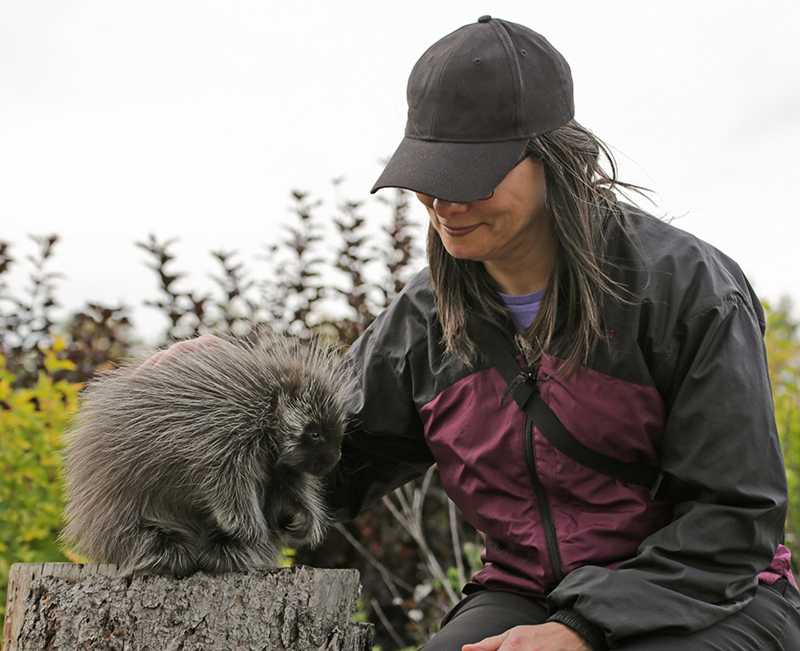 Though we couldn’t touch Koorah, there were no prohibitions about contact with Velcro, and Shonna was smitten with the little guy. He seemed to enjoy her attention, and aside from a couple of little unintentional quill pokes here and there, we came away without injury.
Though we couldn’t touch Koorah, there were no prohibitions about contact with Velcro, and Shonna was smitten with the little guy. He seemed to enjoy her attention, and aside from a couple of little unintentional quill pokes here and there, we came away without injury. It was a wonderful experience, thanks to Serena, Mary and Belinda, who always treat us like family.
It was a wonderful experience, thanks to Serena, Mary and Belinda, who always treat us like family. I took over 3,500 photos, which could be my record for a single day. A professional photographer might criticize my spray-and-pray method, and some have. It means I point the camera, hold down the shutter so it sounds like a machine gun, and gamble that one of the action shots might give me something from which I can paint.
I took over 3,500 photos, which could be my record for a single day. A professional photographer might criticize my spray-and-pray method, and some have. It means I point the camera, hold down the shutter so it sounds like a machine gun, and gamble that one of the action shots might give me something from which I can paint. As I’ve written many times, I do not want to become a professional photographer. I’m looking for painting reference, and there have been plenty of times when the accidental surprising shots inspire the art that follows. So, waiting for the perfect shot and then firing the trigger, as many skilled photographers do, means I might miss out on a look, pose, or head turn that inspires a future piece of art.
As I’ve written many times, I do not want to become a professional photographer. I’m looking for painting reference, and there have been plenty of times when the accidental surprising shots inspire the art that follows. So, waiting for the perfect shot and then firing the trigger, as many skilled photographers do, means I might miss out on a look, pose, or head turn that inspires a future piece of art.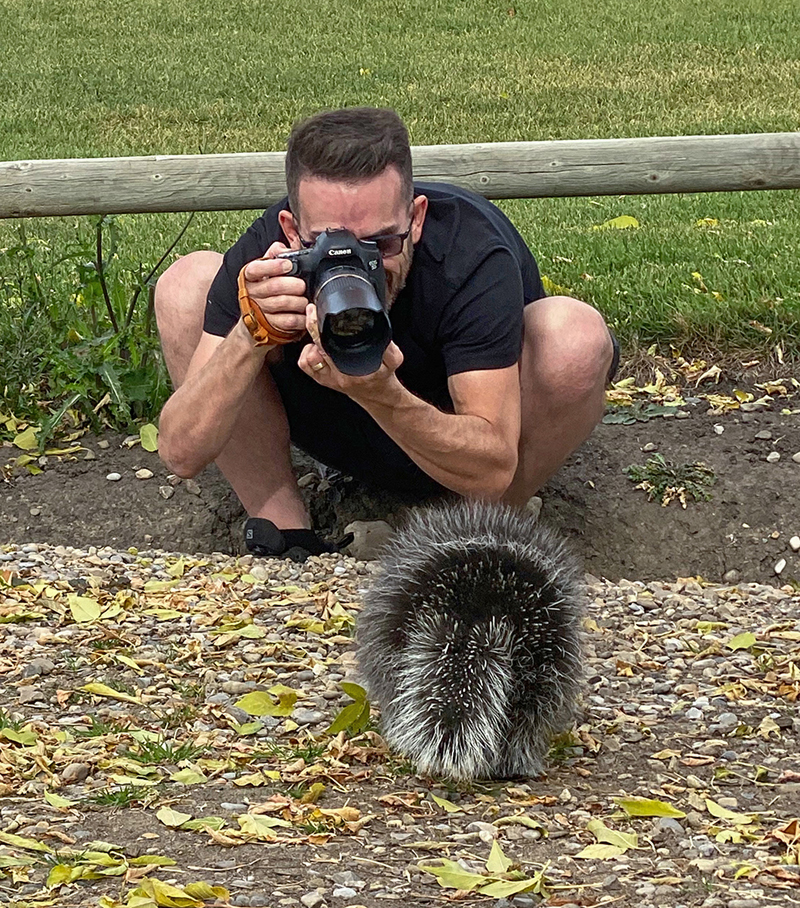 There are two camera cards in my Canon 5D Mark III camera. I don’t need RAW files, so I set it to save duplicate JPEGs. It doesn’t happen often, but camera cards can fail, so duplicate cards are my insurance.
There are two camera cards in my Canon 5D Mark III camera. I don’t need RAW files, so I set it to save duplicate JPEGs. It doesn’t happen often, but camera cards can fail, so duplicate cards are my insurance. Everything else goes in the trash.
Everything else goes in the trash. It feels great to eliminate that many so soon because too much choice is overwhelming. I let them sit for a day or two before going back to ask those same questions again.
It feels great to eliminate that many so soon because too much choice is overwhelming. I let them sit for a day or two before going back to ask those same questions again.
 I edit the photos I’ll share, but not the ones I save for reference, aside from perhaps cropping out unnecessary background. That helps save file space.
I edit the photos I’ll share, but not the ones I save for reference, aside from perhaps cropping out unnecessary background. That helps save file space. Because of other commitments and projects on the go, it will be a while before I start any new paintings from the photos I shot on this trip to Discovery Wildlife Park, but I’m looking forward to that opportunity this winter.
Because of other commitments and projects on the go, it will be a while before I start any new paintings from the photos I shot on this trip to Discovery Wildlife Park, but I’m looking forward to that opportunity this winter.

 Velcro’s Mom was a road casualty, and they suspect he might have been attached to her when it happened. When surrendered to the park, his eyes were scabbed over, and his nose and muzzle abraded. His nose is still healing, but he’s coming along nicely.
Velcro’s Mom was a road casualty, and they suspect he might have been attached to her when it happened. When surrendered to the park, his eyes were scabbed over, and his nose and muzzle abraded. His nose is still healing, but he’s coming along nicely. We took him out to the grass for a bit, and I got some lovely photos. A few of them are downright comical and will make wonderful painting reference. I mentioned I have long wanted to paint a porcupine but have never gotten the proper reference.
We took him out to the grass for a bit, and I got some lovely photos. A few of them are downright comical and will make wonderful painting reference. I mentioned I have long wanted to paint a porcupine but have never gotten the proper reference. After I watched them feed Velcro, Serena told me to go with Belinda in the golf cart and to bring my camera. She wouldn’t tell me where I was going, but after collecting fresh branches from a treed area on the property, we delivered them to Zipper, their adult porcupine. I didn’t even know they had one, likely because I’m usually hyper-focused on the bears.
After I watched them feed Velcro, Serena told me to go with Belinda in the golf cart and to bring my camera. She wouldn’t tell me where I was going, but after collecting fresh branches from a treed area on the property, we delivered them to Zipper, their adult porcupine. I didn’t even know they had one, likely because I’m usually hyper-focused on the bears. It was a hot day, and Zipper wasn’t especially active, so I don’t think I got the best reference from which to paint an adult porcupine, but at least I know where to go for some great opportunities in the future.
It was a hot day, and Zipper wasn’t especially active, so I don’t think I got the best reference from which to paint an adult porcupine, but at least I know where to go for some great opportunities in the future.
 I’ve lost track of how many animals I’ve painted since that first grizzly bear in 2009, but I know it’s more than a hundred.
I’ve lost track of how many animals I’ve painted since that first grizzly bear in 2009, but I know it’s more than a hundred. If you’ve followed my work for longer than five minutes, you’ll know all about her. An orphan rescued from the US in 2017 by my friend Serena at Discovery Wildlife Park in Innisfail, I’ve known Berkley since she was a few months old and have been painting her ever since. Here’s the first one.
If you’ve followed my work for longer than five minutes, you’ll know all about her. An orphan rescued from the US in 2017 by my friend Serena at Discovery Wildlife Park in Innisfail, I’ve known Berkley since she was a few months old and have been painting her ever since. Here’s the first one.
 Serena regularly sends Shonna and I texts and photos of the animals, and we visit Discovery Wildlife Park as often as possible. Not so much the past few years, for obvious reasons, but I intend to change that once the warmer weather arrives.
Serena regularly sends Shonna and I texts and photos of the animals, and we visit Discovery Wildlife Park as often as possible. Not so much the past few years, for obvious reasons, but I intend to change that once the warmer weather arrives. It’s a wonderful feeling that Berkley still knows me each visit and comes to say hello, no matter where she is in her large enclosure.
It’s a wonderful feeling that Berkley still knows me each visit and comes to say hello, no matter where she is in her large enclosure.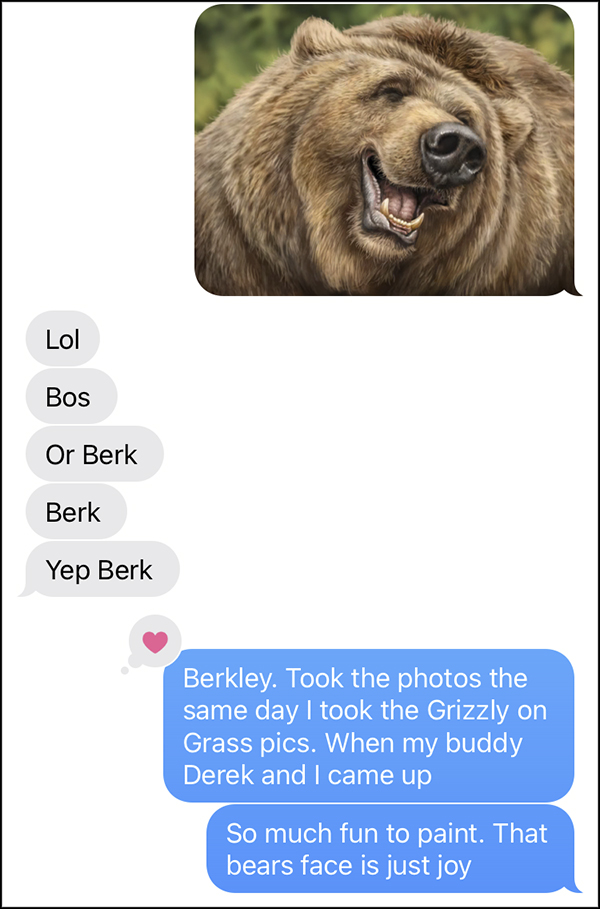


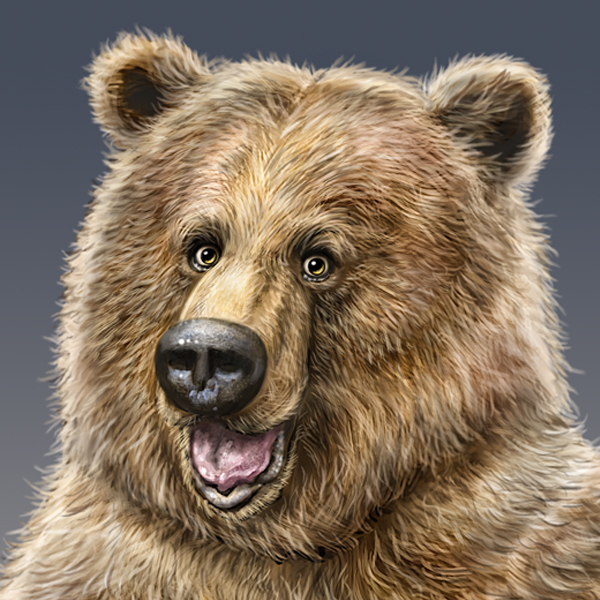



 Last week, I drove to Innisfail to
Last week, I drove to Innisfail to  The Calgary Zoo and Discovery Wildlife Park have a great relationship. Staff from one will often visit the other, participate in educational and training days, and learn from each other’s procedures and policies.
The Calgary Zoo and Discovery Wildlife Park have a great relationship. Staff from one will often visit the other, participate in educational and training days, and learn from each other’s procedures and policies. We got to meet their new wolf pups, though only the keepers who feed them are allowed to touch them. The vet has prohibited any other contact until the pups have their vaccinations next month. But I got plenty of photos, and there will most definitely be a painting coming this year.
We got to meet their new wolf pups, though only the keepers who feed them are allowed to touch them. The vet has prohibited any other contact until the pups have their vaccinations next month. But I got plenty of photos, and there will most definitely be a painting coming this year. After years of failure, I might have finally got the reference I needed to paint an African porcupine. They had just been given food for which they had to work a little, which is a form of enrichment. The lighting was good, I could get down to eye level, and the little critter kept looking right at me. I was shooting through glass, but if there isn’t much glare and I can cup my hand around the lens hood, that often works just fine. I must have taken 300 shots. I discarded most of them on the first pass, but there are painting reference potentials in those I kept.
After years of failure, I might have finally got the reference I needed to paint an African porcupine. They had just been given food for which they had to work a little, which is a form of enrichment. The lighting was good, I could get down to eye level, and the little critter kept looking right at me. I was shooting through glass, but if there isn’t much glare and I can cup my hand around the lens hood, that often works just fine. I must have taken 300 shots. I discarded most of them on the first pass, but there are painting reference potentials in those I kept. The shipment arrived while I was at the zoo, so I sent a text to our next-door neighbours asking them to grab it for me off the step for the third time in recent weeks. For a guy who is home most of the time, all my recent orders have arrived while I’ve been away. My neighbours got the first calendar as a Thank-You, but you can get yours at The Mountain Made Market this weekend at the Canmore Civic Centre.
The shipment arrived while I was at the zoo, so I sent a text to our next-door neighbours asking them to grab it for me off the step for the third time in recent weeks. For a guy who is home most of the time, all my recent orders have arrived while I’ve been away. My neighbours got the first calendar as a Thank-You, but you can get yours at The Mountain Made Market this weekend at the Canmore Civic Centre.
 After more than two years of procrastinating, I finally finished this painting of an African elephant.
After more than two years of procrastinating, I finally finished this painting of an African elephant.
 Secondly, the full-size four-day
Secondly, the full-size four-day  I sent a couple of changes to Serena, and she helped me get it right. She felt bad for having to tell me about it after I’d finished the painting, but I told her better than after I had bought dozens of prints, and coasters, trivets, magnets, and other licensed merchandise had gone into production.
I sent a couple of changes to Serena, and she helped me get it right. She felt bad for having to tell me about it after I’d finished the painting, but I told her better than after I had bought dozens of prints, and coasters, trivets, magnets, and other licensed merchandise had gone into production.





 Earlier this week, Shonna and I were thrilled to be invited to
Earlier this week, Shonna and I were thrilled to be invited to 
 It’s with no small amount of gratitude that I enjoy such a close relationship with Discovery Wildlife Park. Their allowing me close contact with the animals over the past several years is a profound trust I don’t take lightly.
It’s with no small amount of gratitude that I enjoy such a close relationship with Discovery Wildlife Park. Their allowing me close contact with the animals over the past several years is a profound trust I don’t take lightly.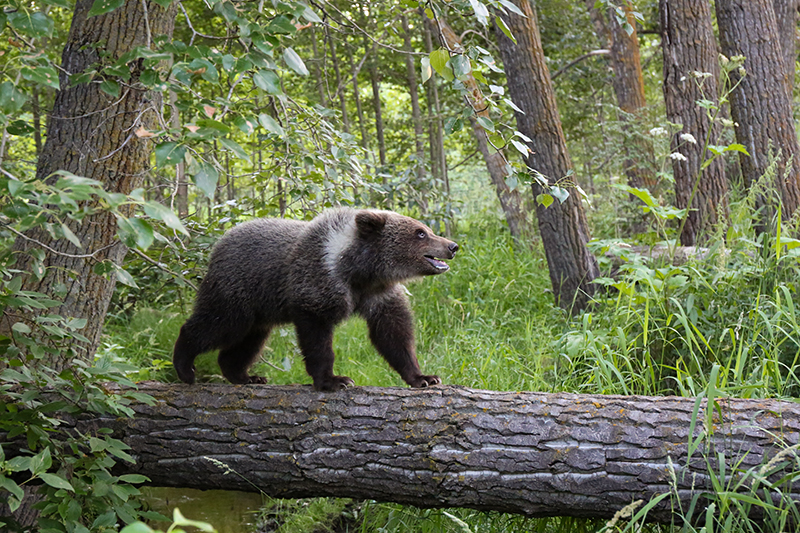 When they’re small, many of the animals spend plenty of time in these woods, where they can run, explore, climb trees, eat berries, and play.
When they’re small, many of the animals spend plenty of time in these woods, where they can run, explore, climb trees, eat berries, and play. The following morning, I sent Serena a text asking how Piper was doing.
The following morning, I sent Serena a text asking how Piper was doing. Bos was much more subdued, a little lazier, but curious and seemed to be enjoying himself as he chewed on trees, dug in the dirt, and wrestled with his adopted sibling.
Bos was much more subdued, a little lazier, but curious and seemed to be enjoying himself as he chewed on trees, dug in the dirt, and wrestled with his adopted sibling.

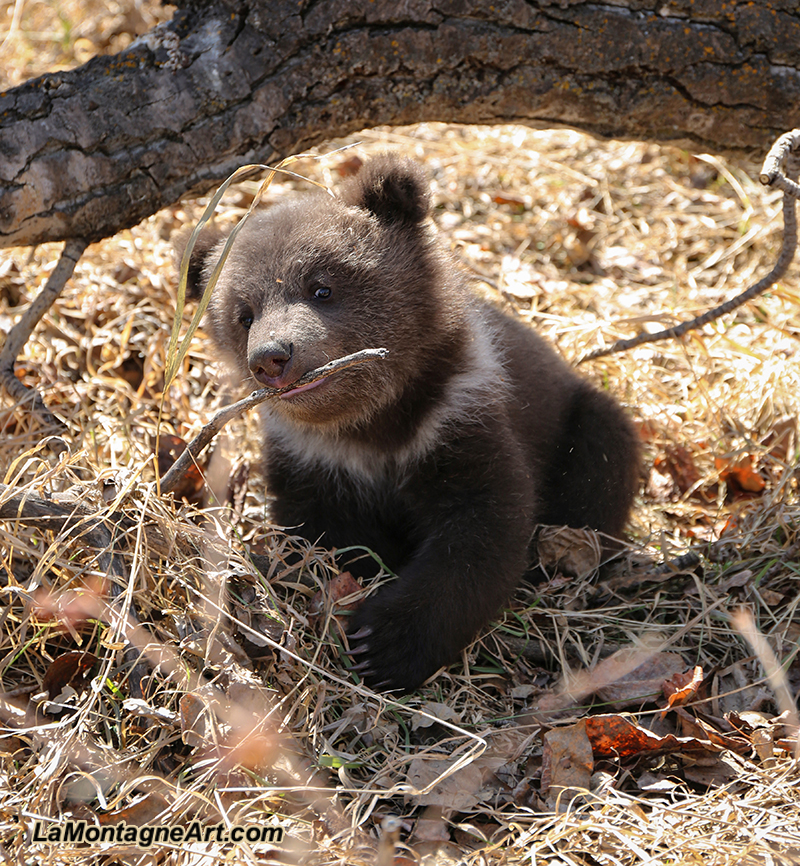 Though she’s always had an overall genial way about her, Berkley went through a bit of a rebellious teenage phase where she would push Serena’s buttons to test her boundaries. It’ll be interesting to see how these cubs grow into their personalities.
Though she’s always had an overall genial way about her, Berkley went through a bit of a rebellious teenage phase where she would push Serena’s buttons to test her boundaries. It’ll be interesting to see how these cubs grow into their personalities. In the hour and a half we were out in the woods with the cubs, I took just under 1500 photos. With bright sunshine and dark shadows, the lighting wasn’t ideal. The bears were often between me and the sun, so I didn’t get as much light on their faces as I would generally like. Hard to complain, though, since I was watching bear cubs play in the woods. I wanted to take some video, but it was too much to handle and would have ruined the experience.
In the hour and a half we were out in the woods with the cubs, I took just under 1500 photos. With bright sunshine and dark shadows, the lighting wasn’t ideal. The bears were often between me and the sun, so I didn’t get as much light on their faces as I would generally like. Hard to complain, though, since I was watching bear cubs play in the woods. I wanted to take some video, but it was too much to handle and would have ruined the experience.
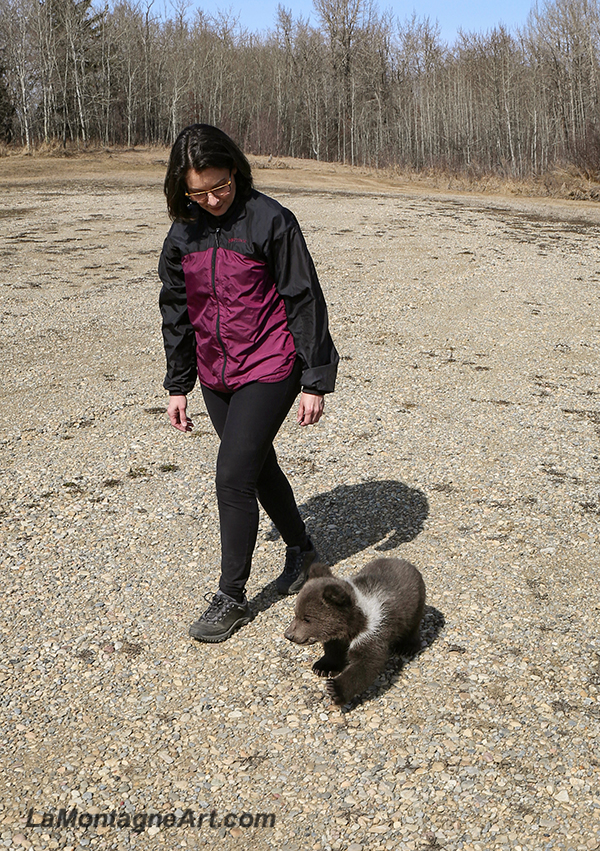
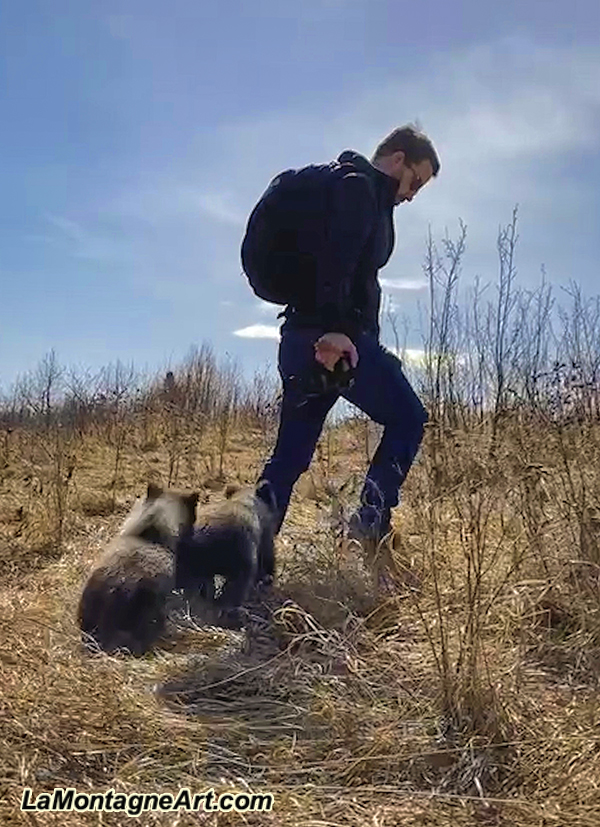 As I don’t like hoarding photos, I’ve already gone through them all and kept just over 100. Most are shots I simply liked, the ones you see here. But I did get about a dozen that I think will be the seeds for future work; there are two paintings in there for sure.
As I don’t like hoarding photos, I’ve already gone through them all and kept just over 100. Most are shots I simply liked, the ones you see here. But I did get about a dozen that I think will be the seeds for future work; there are two paintings in there for sure.
 If you’d like to watch the cubs grow up, you can follow
If you’d like to watch the cubs grow up, you can follow